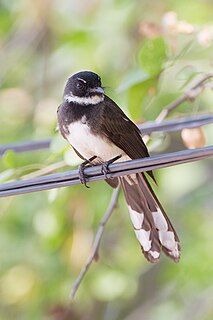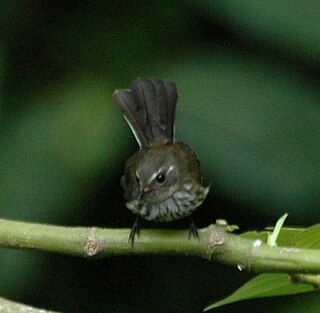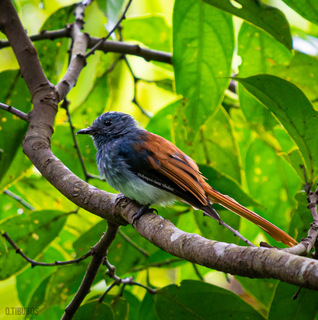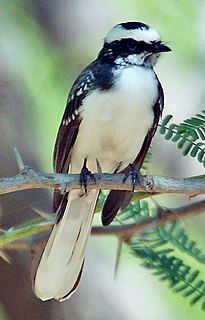 W
WFantails are small insectivorous birds of Australasia, Southeast Asia and the Indian subcontinent belonging to the genus Rhipidura in the family Rhipiduridae. Most of the species are about 15 to 18 cm long, specialist aerial feeders, and named as "fantails", but the Australian willie wagtail is a little larger, and, though still an expert hunter of insects on the wing, concentrates equally on terrestrial prey.
 W
WFantails are small insectivorous birds of Australasia, Southeast Asia and the Indian subcontinent belonging to the genus Rhipidura in the family Rhipiduridae. Most of the species are about 15 to 18 cm long, specialist aerial feeders, and named as "fantails", but the Australian willie wagtail is a little larger, and, though still an expert hunter of insects on the wing, concentrates equally on terrestrial prey.
 W
WThe Arafura fantail, sometimes known as the wood fantail, inhabits the Lesser Sunda Islands, the northern coast of Australia from the Kimberley to the western side of the Cape York Peninsula, including subcoastally in the Top End of the Northern Territory, and southern New Guinea. It is similar to the rufous fantail, from which it has been split taxonomically but, apart from minor overlap in the eastern Moluccas, their geographic ranges are discrete. It is generally duller than the rufous fantail with the rufous colouration more restricted.
 W
WThe black fantail is a species of bird in the family Rhipiduridae. It is found in the highlands of New Guinea. Its natural habitat is subtropical or tropical moist montane forests.
 W
WThe black thicket fantail is a species of bird in the family Rhipiduridae. It is found in the Aru Islands and New Guinea. This species is one of 47 in the genus Rhipidura.
 W
WThe black-and-cinnamon fantail is a species of bird in the fantail family Rhipiduridae. It is endemic to the island of Mindanao in the Philippines. There are two subspecies, the nominate R. n. nigrocinnamomea, from central and southern Mindanao; and R. n. hutchinsoni in north, western and eastern Mindanao. The specific name is derived from Latin niger for black, and cinnamomeus for cinnamon.
 W
WThe blue-headed fantail is a fantail endemic to the northern Philippines where it is found on the islands of Luzon and Catanduanes. Until recently, it was considered conspecific with the Tablas fantail and Visayan fantail.
 W
WThe chestnut-bellied fantail is a species of bird in the family Rhipiduridae. It is found in the Aru Islands and New Guinea. Its natural habitats are subtropical or tropical moist lowland forests and subtropical or tropical moist montane forests.
 W
WThe cinnamon-tailed fantail is a fantail restricted to the Banda Sea Islands of Indonesia.
 W
WCockerell's fantail or the white-winged fantail, is a species of bird in the family Rhipiduridae. It is found throughout the Solomon Islands (archipelago).
 W
WThe dimorphic fantail is a species of bird in the family Rhipiduridae. It is found in New Guinea. Its natural habitat is subtropical or tropical moist montane forests.
 W
WThe friendly fantail is a species of bird in the family Rhipiduridae. It is found in the highlands of New Guinea. Its natural habitat is subtropical or tropical moist montane forests.
 W
WThe grey fantail is a small insectivorous bird. It is a common fantail found in Australia, the Solomon Islands, Vanuatu and New Caledonia. The species is considered by many to be conspecific with the New Zealand fantail ; however, differences in its calls lead some authorities to treat it as a separate species.
 W
WThe Kadavu fantail is a species of bird in the fantail family Rhipiduridae. It is endemic to Kadavu and Ono in the Kadavu archipelago, in southern Fiji. It is closely related to the streaked fantail of the rest of Fiji, and forms a superspecies with the numerous island species of fantail ranging from the Solomon Islands to Samoa.
 W
WThe long-tailed fantail is a species of bird in the family Rhipiduridae. It is endemic to the Tanimbar Islands, where its natural habitat is subtropical or tropical moist lowland forests. It is threatened by habitat loss.
 W
WThe Lord Howe fantail, also known as the Lord Howe Island fantail or fawn-breasted fantail, was a small bird in the fantail family, Rhipiduridae. It is an extinct subspecies of the New Zealand fantail. It was endemic to Lord Howe Island in the Tasman Sea, part of New South Wales, Australia.
 W
WThe Malaysian pied fantail is a species of bird in the fantail family and one of 47 species in the genus Rhipidura. It is locally referred to as murai gila, literally "crazy thrush" in the Malay language. It is found in Brunei, Cambodia, Indonesia, Laos, Malaysia, Myanmar, Philippines, Singapore, Thailand, and Vietnam. Its natural habitat is subtropical or tropical moist lowland forests.
 W
WThe mangrove fantail is a species of bird in the family Rhipiduridae. It is found in the Aru Islands and along the coast of southeastern New Guinea, western and northern Australia.
 W
WThe Manus fantail is a bird species endemic to the Admiralty Islands of Papua New Guinea.
 W
WThe Mindanao blue fantail is a species of bird in the family Rhipiduridae. It is one of 47 species in the genus Rhipidura.
 W
WThe Mussau fantail or Matthias fantail is a fantail which is endemic to Mussau Island in the St. Matthias Islands of Papua New Guinea.
 W
WThe New Zealand fantail is a small insectivorous bird, the only species of fantail in New Zealand. It has four subspecies: R. f. fuliginosa in the South Island, R. f. placabilis in the North Island, R. f. penita in the Chatham Islands, and the now-extinct R. f. cervina formerly on Lord Howe Island. It is also known by its Māori names, pīwakawaka, tīwakawaka or piwaiwaka; the common pied morph is also known as pied fantail, and the uncommon dark morph is also known as black fantail. The species has been considered by many to be conspecific as the grey fantail of Australia and New Caledonia; however, due to significant differences in its calls, many authorities now treat it as a separate species.
 W
WThe northern fantail is a species of bird in the family Rhipiduridae. It is found in New Guinea and northern Australia . Its natural habitats are subtropical or tropical moist lowland forests and subtropical or tropical mangrove forests. The Biak fantail was formerly considered a subspecies.
 W
WThe Palau fantail is a species of bird in the fantail family Rhipiduridae. It is endemic to Palau.
 W
WThe Philippine pied fantail is a species of bird in the family Rhipiduridae. It was formerly considered conspecific with the Malaysian pied fantail.
 W
WThe Pohnpei fantail is a fantail which is endemic to the Pacific island of Pohnpei in the Federated States of Micronesia. It is a bird commonly found in forests and at forest edges. It feeds on insects which it gathers by gleaning amongst foliage or by making short dashes while in the air.
 W
WThe rufous fantail is a small Passerine bird, most commonly known also as the black-breasted rufous-fantail or rufous-fronted fantail, which can be found in Australia, Indonesia, Micronesia, New Guinea and the Solomon Islands. In these countries they inhabit rainforests, wet forests, swamp woodlands and mangroves.
 W
WThe rufous-backed fantail is a species of bird in the family Rhipiduridae. It is found in New Guinea. Its natural habitat is subtropical or tropical moist lowland forests.
 W
WThe rufous-tailed fantail is a species of bird in the family Rhipiduridae. It is endemic to Java in Indonesia. Its natural habitat is subtropical or tropical moist montane forests.
 W
WThe Samoan fantail is a species of bird in the family Rhipiduridae. It is endemic to Samoa.
 W
WThe sooty thicket fantail is a species of bird in the family Rhipiduridae. It is found in New Guinea.
 W
WThe spotted fantail is a species of bird in the family Rhipiduridae.
 W
WThe streak-breasted fantail is a species of bird in the family Rhipiduridae. It is endemic to Indonesia, where it occurs in Seram Island. Its natural habitats are subtropical or tropical moist lowland forests and subtropical or tropical moist montane forests.
 W
WThe streaked fantail is a species of bird in the family Rhipiduridae. Rhipidura verreauxi has precedence over Rhipidura spilodera. It is found in Fiji, New Caledonia, and Vanuatu. Its natural habitats are subtropical or tropical moist lowland forests and subtropical or tropical moist montane forests.
 W
WThe Sulawesi fantail is a species of bird in the family Rhipiduridae. It is endemic to Sulawesi in Indonesia. Its natural habitats are subtropical or tropical moist lowland forests and subtropical or tropical moist montane forests.
 W
WThe tawny-backed fantail, also known as the cinnamon-backed fantail, is a species of bird in the family Rhipiduridae. It is endemic to Buru island in Indonesia. Its natural habitats are subtropical or tropical moist lowland forests and subtropical or tropical moist montane forests. The species occupies an area of larger than 20,000 km2 and has a stable population of above 10,000, and thus is not considered as threatened.
 W
WThe Visayan fantail is a fantail endemic to the Philippines on islands of Negros, Panay, Guimaras, Masbate and Ticao. Until recently, it was considered conspecific with the blue-headed fantail and Tablas fantail.
 W
WThe white-bellied fantail is a species of bird in the family Rhipiduridae.
 W
WThe white-bellied thicket fantail is a species of bird in the family Rhipiduridae. This species is one of 47 in the genus Rhipidura. It is found in New Guinea. Its natural habitats are subtropical or tropical moist lowland forests and subtropical or tropical mangrove forests.
 W
WThe white-browed fantail is a small passerine bird belonging to the family Rhipiduridae.
 W
WThe white-spotted fantail or spot-breasted fantail is a small passerine bird. It is found in forest, scrub and cultivation in southern and central India. It was formerly considered a subspecies of the white-throated fantail.
 W
WThe white-throated fantail is a small passerine bird. It is found in forest, scrub and cultivation across tropical southern Asia from the Himalayas, India and Bangladesh east to Indonesia. The white-spotted fantail until recently was considered a subspecies.
 W
WThe willy wagtail is a passerine bird native to Australia, New Guinea, the Solomon Islands, the Bismarck Archipelago, and Eastern Indonesia. It is a common and familiar bird throughout much of its range, living in most habitats apart from thick forest. Measuring 19–21.5 cm in length, the willie wagtail is contrastingly coloured with almost entirely black upperparts and white underparts; the male and female have similar plumage.